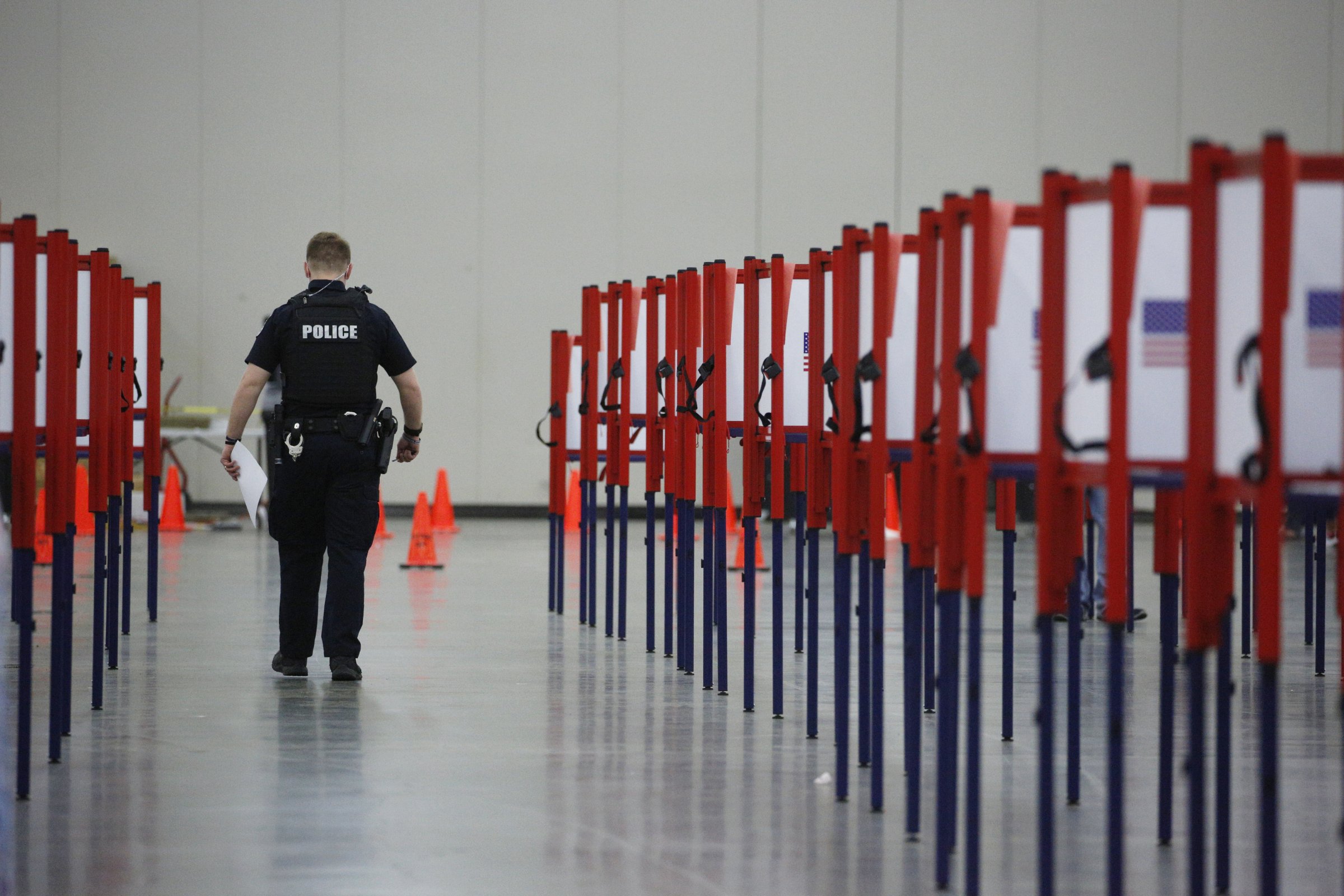
As millions of Americans converge to vote in one of the most contentious elections in U.S. history, police forces across the nation are taking unprecedented steps to brace for potential disruption at the polls and post-election violence.
“It’s fair to say the police are preparing in ways they never would have had to for Election Day,” says Chuck Wexler, executive director of the Police Executive Research Forum, a Washington-based think tank. “This year is unlike any other year.”
With longer lines at poll sites due to social-distancing restrictions and short tempers after months of dealing with multiple national crises, from the pandemic to the economy, it wouldn’t take much to ignite a conflict. Wexler says he can see clashes erupting if someone is not wearing a mask inside a poll site or if a voter’s eligibility to cast a ballot is called into question. “Because this election is more important than it has been in years, you’re going to have people that are going to have frayed nerves,” Wexler says. “You can easily have some kind of confrontation.”
In New York City, police officers will be stationed in more than 1,200 polling sites on Election Day, with hundreds more “at the ready” beginning Oct. 26, NYPD Chief of Department Terence Monahan said at a news conference Tuesday. The nation’s largest police force is deploying more officers to poll sites than usual because it’s “no secret that this election is more contentious than in years past,” Monahan said.
In a more extreme move, the Metropolitan Police Department in Washington, D.C. purchased more than $100,000 worth of less-lethal weapons, including tear gas canisters, on June 1 in preparation for protests and potentially violent demonstrations after the election, WUSA9 reported. Police Chief Peter Newsham defended the purchase, telling local lawmakers that in law enforcement circles, “it is widely believed there will be civil unrest after the November election regardless of who wins,” according to the news outlet.
To limit Election Day chaos in Michigan, election officials last week announced a ban on the open carry of guns at or near polls in the state on Nov. 3. Other law enforcement agencies in Indiana and in the swing state of Florida have created emergency command centers to address any election disturbances as they unfold. The Phoenix Police Department has limited the ability of any officer to take time off during the week of the election.
Since the 2020 presidential election comes on the heels of a tumultuous summer that saw widespread protests and intense anger at police following George Floyd’s death, law enforcement agencies will face the nearly impossible task on Nov. 3 of protecting voters from potential violence without inflaming tensions by their presence alone—all while confidence in the police has reached a record low.
In many jurisdictions, including in Minneapolis, where Floyd died after a police officer knelt on his neck for nearly nine minutes on May 25, law enforcement is not allowed within 100 ft. of polling places on Election Day unless they’re summoned for emergencies. In Arizona’s Maricopa County—the nation’s second-largest voting jurisdiction, with about 2.6 million registered voters—law enforcement is the second line of defense, only after on-site election officials have failed to resolve a conflict.
“We don’t want anybody to feel intimidated with the presence of law enforcement,” Phoenix Police spokeswoman Sgt. Maggie Cox says. “That’s what we want to stay the furthest thing from.” Chris Bailey, the Indianapolis Metropolitan Police Department’s assistant chief, agrees. “If we don’t have a legitimate law enforcement reason to be in the polls, unless we’re voting, we’re going to monitor things from afar,” he says.
One of the biggest drivers of confrontation, according to several law enforcement officials, would be the presence of armed, right-wing militant groups near poll sites. Vigilante groups have been a frequent catalyst for violent confrontations at demonstrations in the last few months, according to human rights advocates. They’re a new Election Day challenge for law enforcement, Wexler says. “This doesn’t usually happen with elections in this country,” he says. “I’ve never seen anything like it.”
During the first presidential debate in September, President Donald Trump urged his supporters to “go into the polls and watch very carefully” after he falsely alleged that poll watchers in Philadelphia were not allowed to observe during the city’s first day of in-person early voting. That same night, he told the Proud Boys, a far-right extremist group, to “stand back and stand by” when he was asked to disavow white supremacy.
But the presence of militia groups at polls could pose real safety concerns in light of a new Amnesty International report that said U.S. law enforcement failed to protect peaceful protesters from violent attacks by armed vigilante groups and counter-protesters in nearly 200 cases from May to September. The report, released Friday, said law enforcement often neglected to deploy an adequate amount of trained officers, separate or de-escalate tensions between opposing groups and often harmed peaceful protesters while dealing with violent ones.
But for officers thrown in the middle, Bailey says, it can be difficult to mediate. “We have to balance and protect the rights of both groups,” he says. “And when one group thinks their cause is greater than the other one, if you’re trying to enforce the rules equally, one or both are going to be upset, no matter what you do.”
“It’s a tough place to be in,” Bailey adds.
More Must-Reads from TIME
- Cybersecurity Experts Are Sounding the Alarm on DOGE
- Meet the 2025 Women of the Year
- The Harsh Truth About Disability Inclusion
- Why Do More Young Adults Have Cancer?
- Colman Domingo Leads With Radical Love
- How to Get Better at Doing Things Alone
- Michelle Zauner Stares Down the Darkness
Contact us at letters@time.com